revolutionary war
 The Washington cousins, George and William, are cousins of my husband’s family as well, and so their heroism is of interest to me. General George Washington, before he became our first president, was a great general, who played a huge part in making the United States the great nation it is. But, there was another cousin, who played a part…whether George Washington knew that or not, I can’t say, but they did work together to bring a victory in the Revolutionary War that was quite unusual in it’s scope…for that era anyway. That cousin, was Henry Knox, who was born on July 25, 1750, the seventh of ten children of William and Mary Knox.
The Washington cousins, George and William, are cousins of my husband’s family as well, and so their heroism is of interest to me. General George Washington, before he became our first president, was a great general, who played a huge part in making the United States the great nation it is. But, there was another cousin, who played a part…whether George Washington knew that or not, I can’t say, but they did work together to bring a victory in the Revolutionary War that was quite unusual in it’s scope…for that era anyway. That cousin, was Henry Knox, who was born on July 25, 1750, the seventh of ten children of William and Mary Knox.
During the Revolutionary War, it was not unusual for armies to winter somewhere, and then pick up the war in the spring. Because they couldn’t go from place to place as quickly then as they do now, they were left with little choice. Soldiers could die in the frigid conditions, if they didn’t find someplace to wait out the winter months…or so it was thought. Knox was in the military serving with Massachusetts forces in the Army of Observation during the opening days of the Siege of Boston. His abilities soon brought him to the attention of new army commander General George Washington when the general inspected fortifications designed by Knox near Roxbury. The two men quickly became friends. When the army desperately needed artillery, Washington consulted Knox for advice in November 1775. Knox suggested the idea that the 59 cannons recently captured at the fall of forts Ticonderoga and Crown Point in upstate New York  could have a decisive impact on the outcome of the siege. Knox did not have a commission in the army, but John Adams in particular worked in the Second Continental Congress to acquire for him a commission as colonel of the army’s artillery regiment. Washington was so impressed that he put Knox in charge of an expedition to retrieve them even though Knox’s commission had not yet arrived. Reaching Ticonderoga on December 5, 1775, Knox commenced what came to be known as the noble train of artillery, hauling by ox-drawn sled 60 tons of cannons and other armaments across some 300 miles of ice covered rivers and snow draped Berkshire Mountains to the Boston siege camps.
could have a decisive impact on the outcome of the siege. Knox did not have a commission in the army, but John Adams in particular worked in the Second Continental Congress to acquire for him a commission as colonel of the army’s artillery regiment. Washington was so impressed that he put Knox in charge of an expedition to retrieve them even though Knox’s commission had not yet arrived. Reaching Ticonderoga on December 5, 1775, Knox commenced what came to be known as the noble train of artillery, hauling by ox-drawn sled 60 tons of cannons and other armaments across some 300 miles of ice covered rivers and snow draped Berkshire Mountains to the Boston siege camps.
The region they were traveling through to reach Boston was lightly populated and Knox had to overcome difficulties with hiring personnel and obtaining animals. On several occasions cannons crashed through the ice on river crossings, but the detail’s men were always able to recover them. In the end, what Knox had expected to take just two weeks actually took more than six, but he was finally able to report the arrival of the weapons train to Washington on January 27, 1776. The operation was called “one of the most stupendous feats of logistics” of the entire war by historian Victor Brooks. Knox’s effort is commemorated by a series of plaques marking the Henry Knox Trail in New York and Massachusetts.

Upon their arrival in Cambridge the cannons were immediately deployed to fortify the Dorchester Heights recently taken by Washington. So commanding was the new battery over Boston harbor the British withdrew their fleet to Halifax. With the siege ended, Knox undertook the improvement of defenses in Connecticut, Rhode Island, and New York City in anticipation of British attack there. In New York he met Alexander Hamilton, commander of the local artillery. The two men formed a close friendship that lasted until Hamilton’s death in 1804. During his military service Knox also established a close friendship with fellow Massachusetts native Benjamin Lincoln. Henry Knox would go down in history as being one of the great strategists in this nation.
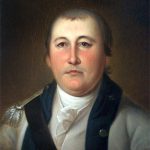 The Revolutionary War is an interesting war in many ways, because while they were limited in the weapons of warfare, they still managed to wage war in a very effective way. Especially in that approximately 12,000 men were killed in action, and the number of men who died from disease, was far more than that. About all the soldiers had to fight with were cannons, and rifles…of the most antiquated sort. Nevertheless, they did the job…most of the time. The biggest problems included a lack of ammunition, and the weight of the cannons.
The Revolutionary War is an interesting war in many ways, because while they were limited in the weapons of warfare, they still managed to wage war in a very effective way. Especially in that approximately 12,000 men were killed in action, and the number of men who died from disease, was far more than that. About all the soldiers had to fight with were cannons, and rifles…of the most antiquated sort. Nevertheless, they did the job…most of the time. The biggest problems included a lack of ammunition, and the weight of the cannons.
The fighting was brutal, with wins and losses on both sides. After nearly a year of the backcountry conflict between Colonel William Washington, who was General George Washington’s second cousin once removed, and the British commander, Lieutenant Colonel Banastre Tarleton, who was infamous for Tarleton’s Quarter, the murder of colonial prisoners of war on May 29, 1780 at Waxhaws, Colonel Washington had retreated to North Carolina the previous October. Orders came from Brigadier General Daniel, commanding Washington to return to the South Carolina theater. Colonel Washington still lacked the proper artillery to properly fight off the Loyalists, who were under the command of Colonel Rowland Rugeley. 
On this day, December 4, 1780, a force of Continental dragoons commanded by Colonel Washington cornered Colonel Rugeley and his followers in Rugeley’s house and barn near Camden, South Carolina. He told his cavalrymen to dismount and surround the barn. While out of Rugeley’s sight, Washington’s men fabricated a pine log to resemble a cannon. This was a Quaker gun trick, named so because the Quakers used it to be intimidating without breaching their pacifist vow of non-violence, and for Colonel William Washington and his men, it worked beautifully. Washington faced the log cannon toward the buildings in which the Loyalists had barricaded themselves and threatened bombardment, if they did not surrender. Shortly after that, Rugeley surrendered his entire force without a single shot being fired. It was an amazing use of strategy, illusion, and forethought on the part of Colonel Washington, and quite likely saved the lives of many of his men.
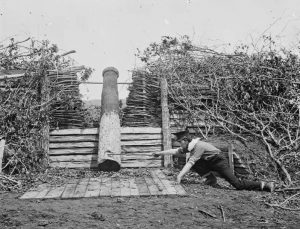
When Lord Charles Cornwallis, commander of the British armies in America, was informed of the pacifist victory, he told Tarleton that Rugeley’s performance ensured he would never rise to the rank of brigadier general. I suppose Cornwallis thought that Tarleton’s men weren’t properly trained. A few weeks later, Tarleton would himself face an even worse humiliation at the hands of General Daniel Morgan during the devastating Battle of Cowpens. The brutal civil war for the hearts and minds of the Carolina backcountry had finally begun to favor the Patriots. Of course, as we now know, the final outcome would be victory and independence for the American Patriots.
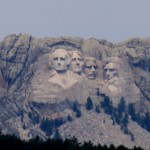 For me, there is no more perfect way to celebrate Independence Day that to come to the Black Hills of South Dakota. I can’t think of a more patriotic place that is close enough to my home in Wyoming to be able to go to each year. The Black Hills is a shrine to patriotism. Mount Rushmore…home to the faces of four presidents, George Washington, Thomas Jefferson, Theodore Roosevelt, and Abraham Lincoln…brings home that spirit of patriotism that lives inside me. I love going to Mount Rushmore, and every time I go, I feel a sense of awe. These great men did the things necessary to make our country great. We don’t often think about the sacrifice a president made, but George Washington was a great soldier before he was president. He, along with the help of an ancestor of my husband, Bob’s, Henry Knox worked out a strategy to win the Revolutionary War, thereby winning our independence. Thomas Jefferson was the author of the Declaration of Independence. Abraham Lincoln was the
For me, there is no more perfect way to celebrate Independence Day that to come to the Black Hills of South Dakota. I can’t think of a more patriotic place that is close enough to my home in Wyoming to be able to go to each year. The Black Hills is a shrine to patriotism. Mount Rushmore…home to the faces of four presidents, George Washington, Thomas Jefferson, Theodore Roosevelt, and Abraham Lincoln…brings home that spirit of patriotism that lives inside me. I love going to Mount Rushmore, and every time I go, I feel a sense of awe. These great men did the things necessary to make our country great. We don’t often think about the sacrifice a president made, but George Washington was a great soldier before he was president. He, along with the help of an ancestor of my husband, Bob’s, Henry Knox worked out a strategy to win the Revolutionary War, thereby winning our independence. Thomas Jefferson was the author of the Declaration of Independence. Abraham Lincoln was the 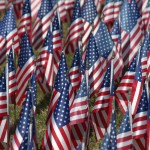 man responsible for ending slavery in the United States, and Teddy Roosevelt was chosen because of his contributions to business, conservation and the creation of the Panama Canal. These were four men who saw just how great this nation could be, and who worked to make sure that it always would be a great Constitutional Republic.
man responsible for ending slavery in the United States, and Teddy Roosevelt was chosen because of his contributions to business, conservation and the creation of the Panama Canal. These were four men who saw just how great this nation could be, and who worked to make sure that it always would be a great Constitutional Republic.
For most of us, the Independence Day celebration would not be complete without a grand fireworks display. I have been to a lot of fireworks displays in my lifetime, but few can match the display that takes place every year in Custer, South Dakota. They start by doing the roll call of the states. I have been amazed over the years that almost every state is represented. Then the fireworks begin, with synchronized music, that is the best mix I have ever heard. Of course, every patriotic song in existence is sung, and the display seems to go on for hours. By the time the evening is over, you truly feel like you have celebrated our nation’s birth. I always walk away feeling more patriotic than when I arrived…if that’s possible.
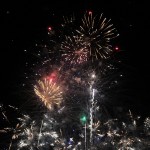
I believe that the United States of America is one of the greatest countries on earth, and in the past few years, people have been trying to tear it down, and make us believe that we are not a great nation with great people. I don’t like that. I don’t like that our government tries to take away our rights, and tries to change the fabric of this nation into a nation of whiney babies that I hardly recognize. I hate to make Independence Day a story about the election, but it’s time to “Make America Great Again.” It’s time to fight for our Constitution, and the freedoms it provides. If we don’t fight for those rights now, they will be gone forever, and with them would go the nation we love. I pray that you all have a very safe and happy Independence Day!!
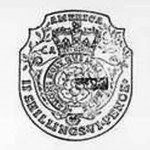 During the years that the colonies were still a part of Great Britain, it was necessary to have troops from Great Britain come and help to defend us during the French and Indian War which took place between 1754 to 1763, and Pontiac’s Rebellion from 1763 to 1764. These were quite costly wars, and to help with recuperate the losses, Great Britain enacted the Sugar Act, which while irritating to the people of the colonies, but it was hidden in the cost of import duties, and so the people accepted it. The enactment of The Stamp Act was a different story, however. The Stamp Act was a tax that Great Britain levied on just the colonies and was strongly disputed. So strongly in fact, that it led to the Revolutionary War.
During the years that the colonies were still a part of Great Britain, it was necessary to have troops from Great Britain come and help to defend us during the French and Indian War which took place between 1754 to 1763, and Pontiac’s Rebellion from 1763 to 1764. These were quite costly wars, and to help with recuperate the losses, Great Britain enacted the Sugar Act, which while irritating to the people of the colonies, but it was hidden in the cost of import duties, and so the people accepted it. The enactment of The Stamp Act was a different story, however. The Stamp Act was a tax that Great Britain levied on just the colonies and was strongly disputed. So strongly in fact, that it led to the Revolutionary War.
The Stamp Act was not what people might think it was. It was not when the use of postage stamps were first introduced. The Stamp Act went so much further than that. The Stamp Act was designed to force colonists to use special stamped paper in the printing of newspapers, pamphlets, almanacs, and playing cards, and to have a stamp embossed on all commercial and legal papers. The stamp itself displayed an image of a Tudor rose framed by the word “America” and the French phrase Honi soit qui mal y pense, meaning ”Shame to him who thinks evil of it.” Of course, the cost of said paper was high, and the colonists ere outraged. This was taxation, without representation, and it was not going to be tolerated.
Massachusetts politician Samuel Adams organized the secret Sons of Liberty organization. They planned protests against the measure, and the Virginia legislature and other colonial assemblies passed resolutions opposing the act. In October, nine colonies sent representatives to New York to attend a Stamp Act Congress, where resolutions of “rights and grievances” were framed and sent to Parliament and King George III. Their voices landed on deaf ears, and The Stamp Act was enacted on this day, November 1, 1765.
The colonists acted quickly. The arrival of the stamps to stamp the paper brought violence and economic retaliation. The colonists began a general boycott of British goods. The Sons of Liberty staged attacks on the customhouses and homes of tax collectors in Boston. The protests and economic turmoil went on for months. Finally, Benjamin Franklin appealed to the British House of Commons. Parliament took a vote, and they repealed The Stamp Act in March 1766. The same day, they made the mistake of passing Declaratory Acts, stating that the British government had free and total legislative power over the colonies.
This would prove to be their downfall. Parliament attempted to force unpopular taxation measures on the American colonies in the late 1760s. This action lead to a steady, and eventually complete, deterioration in British-American relations that brought about the outbreak of the American Revolution in 1775, and the eventual Declaration of Independence of America from Great Britain. It was a hard lesson for Great Britain to  learn, and on that some political parties, namely the Democrats have not learned yet. When you tax the people too heavily, they will rebel, and the outcome will not be in the favor of that abusive government. If taxes are lower, the country will grow. Entrepreneurs will begin new ventures, and the country will prosper, and with prosperity, comes the natural process of more money to run the government. Ours is a nation of independent thinkers, and people of action. Taxes that are too high and unfair, stifle that independent thinking and slow down that action. It is just the opposite of what the proponents of a grossly obese government would expect, but it is nevertheless, the way it works. Our government would do well to realize that, and make a change.
learn, and on that some political parties, namely the Democrats have not learned yet. When you tax the people too heavily, they will rebel, and the outcome will not be in the favor of that abusive government. If taxes are lower, the country will grow. Entrepreneurs will begin new ventures, and the country will prosper, and with prosperity, comes the natural process of more money to run the government. Ours is a nation of independent thinkers, and people of action. Taxes that are too high and unfair, stifle that independent thinking and slow down that action. It is just the opposite of what the proponents of a grossly obese government would expect, but it is nevertheless, the way it works. Our government would do well to realize that, and make a change.
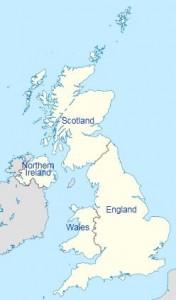 Many people may not be aware that in the United Kingdom of Great Britain, there is almost a constant state of confusion over just exactly who they are. They are considered Great Britain or the United Kingdom, but the United Kingdom takes in the countries of England, Scotland, Wales and Northern Ireland. It was on this day May 1, 1707 that England and Scotland joined together to become the United Kingdom. I think the union must have been a bit surprising, given that the English and the Scots had long battled over one thing or another. Nevertheless, The Scots needed the economic support that England could offer, while for England the merger was political. The Scots would no longer have a Parliment, but they were given instead a proportion of the seats at Westminster.
Many people may not be aware that in the United Kingdom of Great Britain, there is almost a constant state of confusion over just exactly who they are. They are considered Great Britain or the United Kingdom, but the United Kingdom takes in the countries of England, Scotland, Wales and Northern Ireland. It was on this day May 1, 1707 that England and Scotland joined together to become the United Kingdom. I think the union must have been a bit surprising, given that the English and the Scots had long battled over one thing or another. Nevertheless, The Scots needed the economic support that England could offer, while for England the merger was political. The Scots would no longer have a Parliment, but they were given instead a proportion of the seats at Westminster.
The English tend to call Great Britain, England, with notorious disregard for the feelings of the Welsh, with whom they joined in 1536 and the Scots, with whom they joined in 1707. The Act of Union of 1707, states merely that England and Scotland shall ‘be united into one kingdom by the name of Great Britain’. Many people simply lumped them together as Britain, calling all of them the Brits, which technically isn’t so…and even the English didn’t like that name. The last official merger was with Northern Ireland in 1800, at which time the enlarged kingdom became the United Kingdom of Great Britain.
It’s hard for me to think about being a country that is part of a kingdom, and yet, I suppose that is exactly what we were when the United States of America was part of England. Although we may not have been considered a part of a kingdom exactly, we were under British rule until the Revolutionary War. I suppose that there could be a love/hate relationship among the countries of the United Kingdom to this day. I do think that the British Royals do like to go to the different countries that are a part of the United Kingdom, and maybe 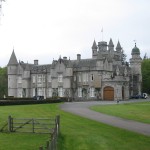
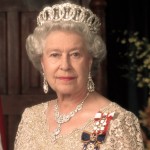 those countries like having them come for a visit now, but I have to wonder if that was always the case. Queen Elizabeth heads to her Scottish castle, Balmoral, at this time of the year, so she must love the whole Scottish countryside at least almost as much as she does England. For Queen Elizabeth, having a castle in Scotland is normal. I suppose that if you grew up being a part of a kingdom, it would be normal, and in all reality, while it wasn’t always a kingdom, it has been since 1536, so it might as well have been always…at least for the people who call the United Kingdom of Great Britain home.
those countries like having them come for a visit now, but I have to wonder if that was always the case. Queen Elizabeth heads to her Scottish castle, Balmoral, at this time of the year, so she must love the whole Scottish countryside at least almost as much as she does England. For Queen Elizabeth, having a castle in Scotland is normal. I suppose that if you grew up being a part of a kingdom, it would be normal, and in all reality, while it wasn’t always a kingdom, it has been since 1536, so it might as well have been always…at least for the people who call the United Kingdom of Great Britain home.
 Twelve years ago today, our world was changed forever. In my remembrance and that of all living Americans, there has never been never been such an attack…here, on American soil…until September 11, 2001. That day will live in the memories of all the American people who were old enough to remember it, and any who have been told very much about it since. I have to wonder about the people born since that time. Will they understand what that day is all about? Or will they simply see it in the way most of us see things like the Civil War or the American Revolutionary War? Both were events that took place here in America so very long ago, fought on American soil, and yet, they seem more like a storybook event than a real event that is such a big part of our history. I don’t know how that could have been
Twelve years ago today, our world was changed forever. In my remembrance and that of all living Americans, there has never been never been such an attack…here, on American soil…until September 11, 2001. That day will live in the memories of all the American people who were old enough to remember it, and any who have been told very much about it since. I have to wonder about the people born since that time. Will they understand what that day is all about? Or will they simply see it in the way most of us see things like the Civil War or the American Revolutionary War? Both were events that took place here in America so very long ago, fought on American soil, and yet, they seem more like a storybook event than a real event that is such a big part of our history. I don’t know how that could have been  changed in the years following those wars, but with our technology, we should be able to keep the memory of the terrorist attacks in the front of our children’s thoughts, so that as they grow, we don’t lose sight of what the evil in this world can bring about.
changed in the years following those wars, but with our technology, we should be able to keep the memory of the terrorist attacks in the front of our children’s thoughts, so that as they grow, we don’t lose sight of what the evil in this world can bring about.
I did not know anyone who lost their life on 9-11, but I did know someone who could have been in the middle of that whole thing. My daughter’s friend, Carina, who has been like a third daughter to me since they were in Kindergarten, was a flight attendant during that time with Continental Airlines, based out of New Jersey. She was sick that day, and so was not flying. That did not alleviate her parents’ concerns, because they didn’t know that she was not flying and they  couldn’t get a hold of her, because she had turned her phone off. When we knew that she was safe, we all gave a sigh of relief. It is a feeling of relief that we will never forget.
couldn’t get a hold of her, because she had turned her phone off. When we knew that she was safe, we all gave a sigh of relief. It is a feeling of relief that we will never forget.
Now twelve years later we are again remembering a horrible terrorist attack against our nation, this time in Benghazi. Our government became too complacent about our safety both here and abroad, and again…people died…on a day when we should have been watchful!!! It is an atrocity!! When will we learn that we cannot forget. There is so much evil in this world and we must remain watchful, or we will be attacked again. Today, I pay tribute to those lost in all of these attacks, and to those who gave their lives trying to help others. Rest in peace.

